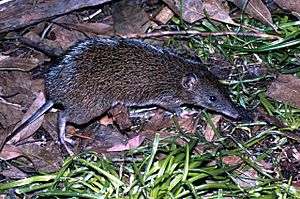Becher Point Wetlands facts for kids
Quick facts for kids
Designations
|
|
| Official name: Becher Point Wetlands | |
| Designated: | 5 January 2001 |
|---|---|
| Reference #: | 1048 |
The Becher Point Wetlands is a special wetland nature reserve. It is located in Port Kennedy, which is in the south-western part of Western Australia. This coastal area is about 677 hectares (about 1673 acres) big. It sits within the City of Rockingham, about 50 kilometers (31 miles) south of Perth, the state capital. Many homes and neighborhoods surround the reserve on the land side. Inside the reserve, you can find around 200 very small wetlands. They are nestled among sand ridges between Becher Point and the Perth-Mandurah Road.
Contents
Why Becher Point Wetlands Are Special
This nature reserve was created between 1996 and 1997. It is recognized as a very important place around the world. On January 5, 2001, it became a "Ramsar Site." This means it is protected under the Ramsar Convention, an international agreement for wetlands. The sedgelands, which are areas with grass-like plants called sedges, are also very important. They are listed as a threatened ecological community under an Australian law called the Environment Protection and Biodiversity Conservation Act 1999. This means these plant groups need special protection. The site is also listed on Australia’s Register of the National Estate, showing its national importance.
What Are Becher Point Wetlands Like?
The reserve is located on flat areas near the coast at Becher Point. Its wetlands are quite close to the Indian Ocean, ranging from 200 to 1500 meters (about 650 to 4900 feet) away. The wetlands are arranged in about ten groups. These groups run roughly parallel to the coast. Sand ridges separate each group.
This area has unique shrub swamps and seasonal marshes. They formed in valleys between sand dunes. These valleys were created as the coastline slowly moved forward over the last three thousand years. This type of wetland system is rare in Southwest Australia. It is one of the newest wetland systems on the Swan Coastal Plain. It shows how wetlands develop over time in terms of water, land shape, and plants. This makes it very special in Western Australia.
Water in the Wetlands
The average yearly rainfall in Rockingham is about 818 to 826 millimeters (around 32 inches). Most of this rain falls in winter, from May to August. However, about 1900 millimeters (75 inches) of water evaporates each year. This means the wetlands are seasonal. They usually do not have surface water during summer and autumn. The fresh water you see on the surface in winter comes from rain and groundwater. This water is usually less than 0.3 meters (about 1 foot) deep.
Animals and Plants of Becher Point
The swamps at Becher Point are home to different types of plants. You can find sedgelands, which are areas with tall, open shrubs. There are also low, open forests or woodlands. The sedgelands are mostly made up of plants like Baumea articulate, B. juncea, Typha species, and Lepidosperma species. Other plants like Schoenoplectus validus, Isolepis nodosa, and Juncus kraussii also grow here.
The forests and woodlands are mainly filled with paperbark trees. These include Melaleuca rhaphiophylla, M. hamulosa, M. cuticularis, and M. teretifolia. The areas around the wetlands have open heathlands.
Wildlife You Might See
Many native animals live at this site. You might spot a southern brown bandicoot, also known as a quenda. Other animals include the southern carpet python and the black-striped snake. At least four different kinds of frogs have been seen here. Also, records show that 21 different types of reptiles call this place home.


